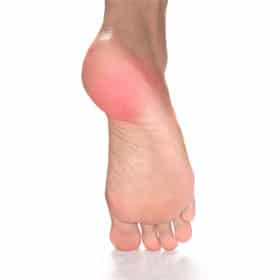Here at Foot Solutions, we know that conditions that affect the feet can have a huge impact on your life. Heel spurs are bony growths that develop around the heel bone when ligaments or tendons become inflamed, and this is often due to inflammatory diseases, such as reactive arthritis, or repetitive strain while exercising.
Many people realise they have heel spurs when they feel a sharp pain in the area on sitting or standing up from rest. In extreme cases, the condition will require surgery to correct the heel spurs, but most people are able to treat themselves at home. Read on to find out how you can do this.
Treatment For Heel Spurs:
If you have noticed a sharp pain in your heel, you should visit your doctor, who may diagnose heel spurs using ultrasound or x-rays. You can talk to your doctor about your options, and it is likely that you will be able to obtain relief from the condition with the following measures:
- Ice treatment. Ice is very useful in treating many foot conditions since it helps to reduce inflammation in the affected area and reduce pain. You can apply ice treatment by wrapping an ice pack or bag of ice in a cloth and holding this onto your heel for up to fifteen minutes. You should allow at least an hour for the area to recover before repeating this treatment.
- Try custom inserts. Custom inserts are designed to fit your feet exactly, and to make sure that your weight is distributed evenly across your shoes. This can provide a great deal of relief from a condition such as heel spurs, and can help to prevent further foot problems developing.
- Check your shoes. Problems such as heel spurs can be exacerbated by wearing shoes that do not fit or support the feet properly. If you do a lot of exercise or sports, it is even more important to ensure that your shoes offer enough protection for your feet. Visit a specialist shoe store such as Foot Solutions and let our professional fitters show you how much difference the right shoes can make.
- Over the counter medication. You may find that anti-inflammatory medication helps to relieve the pain you feel while your heel spurs are causing inflammation, and you can discuss this with your doctor or pharmacist. Taking pain relief should only be a short term measure, however, and you should seek advice if you continue to experience pain.
- Stretching. Heel spurs are common amongst athletes, and changing the way that you practice your sport can help. Ensuring that you warm up and down thoroughly can help to prevent injuries and conditions such as this, and taking measures to protect your feet while you exercise can make a big difference.
Find Comfortable Shoes in Ireland
Visit Foot Solutions for professional fitting advice and measuring, and talk to our experienced team to find the best solution for you. We can advise you on the best measures to treat a wide range of foot conditions, often including customised arch supports, well fitted shoes and comfort socks that will make your feet feel great.

































